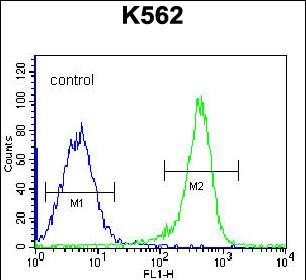

| WB | 1/1000 | Human,Mouse,Rat |
| IF | 咨询技术 | Human,Mouse,Rat |
| IHC | 咨询技术 | Human,Mouse,Rat |
| ICC | 技术咨询 | Human,Mouse,Rat |
| FCM | 1/10-1/50 | Human,Mouse,Rat |
| Elisa | 咨询技术 | Human,Mouse,Rat |
| Aliases | Proline-serine-threonine phosphatase-interacting protein 1, PEST phosphatase-interacting protein 1, CD2-binding protein 1, H-PIP, PSTPIP1, CD2BP1 |
| Entrez GeneID | 9051 |
| WB Predicted band size | 47.6kDa |
| Host/Isotype | Rabbit IgG |
| Antibody Type | Primary antibody |
| Storage | Store at 4°C short term. Aliquot and store at -20°C long term. Avoid freeze/thaw cycles. |
| Species Reactivity | Human |
| Immunogen | This PSTPIP1 antibody is generated from rabbits immunized with a KLH conjugated synthetic peptide between 89-118 amino acids from the N-terminal region of human PSTPIP1. |
| Formulation | Purified antibody in PBS with 0.05% sodium azide. |
+ +
以下是关于PSTPIP1(N-term)抗体的3篇参考文献,按文献名称、作者和摘要内容简要概括:
---
1. **文献名称**: *"PSTPIP1 regulates inflammasome activation in macrophages"*
**作者**: Shao F. et al.
**摘要**: 研究使用抗PSTPIP1(N-term)抗体进行Western blot分析,发现PSTPIP1通过N端结构域与ASC蛋白相互作用,调控炎症小体的组装及IL-1β的分泌,揭示了其在先天免疫中的功能。
---
2. **文献名称**: *"Mutations in PSTPIP1 cause autoinflammatory PAPA syndrome by altering protein-protein interactions"*
**作者**: Wise CA. et al.
**摘要**: 通过免疫共沉淀实验(使用N端特异性抗体),作者发现PSTPIP1的致病突变(如E250K)破坏其与PTP-PEST的结合,导致过度磷酸化及炎症信号通路的异常激活,阐明了PAPA综合征的分子机制。
---
3. **文献名称**: *"Structural basis of PSTPIP1 tyrosine phosphorylation in CD2-mediated T cell adhesion"*
**作者**: Badour K. et al.
**摘要**: 利用抗PSTPIP1 N端抗体进行免疫荧光定位,研究揭示了PSTPIP1的N端卷曲螺旋结构域对T细胞黏附的关键作用,并证明其磷酸化状态影响与CD2受体信号通路的偶联。
---
这些文献均通过PSTPIP1 N端特异性抗体探索了该蛋白在炎症、疾病突变及细胞信号传导中的功能。如需具体期刊信息或发表年份,建议通过PubMed或期刊数据库进一步检索。
The PSTPIP1 (N-term) antibody targets the N-terminal region of Proline-Serine-Threonine Phosphatase-Interacting Protein 1 (PSTPIP1), a cytoskeletal regulatory protein involved in immune cell function. PSTPIP1 interacts with the Wiskott-Aldrich syndrome protein (WASP) to modulate actin cytoskeleton reorganization, impacting processes like cell motility, immune synapse formation, and cytokine secretion. This antibody is commonly used in research to study PSTPIP1 expression, localization, and its role in inflammatory disorders, particularly PAPA syndrome (Pyogenic Arthritis, Pyoderma Gangrenosum, and Acne), caused by PSTPIP1 mutations.
The N-terminal region of PSTPIP1 contains critical binding domains for proteins like PEST-type tyrosine phosphatases (PTP-PEST) and coiled-coil motifs, making this antibody valuable for investigating molecular interactions and signaling pathways. It is widely applied in techniques such as Western blotting, immunofluorescence, and immunohistochemistry to assess protein levels in immune cells (e.g., macrophages, T-cells) or disease models. Researchers also utilize it to explore aberrant PSTPIP1 behavior linked to autoinflammatory diseases or immune dysregulation.
Note that PSTPIP1 migrates at ~78-80 kDa, though post-translational modifications (e.g., tyrosine phosphorylation) may alter its electrophoretic mobility. Specificity should be confirmed via knockout controls or siRNA knockdown, as cross-reactivity with homologous proteins (e.g., PSTPIP2) is possible. This tool remains essential for dissecting PSTPIP1's role in immunity and inflammation.
×